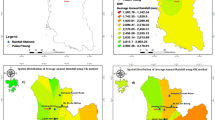Abstract
A quick and simple procedure has been developed for evaluating maximum point rainfall for different return periods for any location in the plains of north India. According to this procedure, 2-year one-day rainfall of a location is estimated from the 2-year generalized chart of the region. Average district rainfall ratios for higher return periods of 5, 10, 25 and 50 years to 2-year return period are obtained with the help of (i) district average ratio map of 100/2 and (ii) frequency interpolation nomogram. The magnitudes of 5, 10, 25, 50 and 100-year rainfall are then obtained by multiplying the 2-year value by the corresponding district average ratios pertaining to different return periods. The estimates of point rainfall obtained by this procedure are quite comparable with those obtained directly by the Gumbel method. By using the procedure given in this study, a design engineer or a hydrologist can estimate point rainfall of different return periods for any station in north Indian plains without undertaking elaborate statistical calculations.
Similar content being viewed by others
References
Ackerman, W. C. (1964),Application of severe rainstorm data in engineering design, Bull. Am. Met. Soc.45, No. 4.
Chow, V. T. (1964),Handbook of Applied Hydrology, McGraw-Hill Book Co., New York.
Dhar, O. N. andKulkarni, A. K. (1970),Estimation of maximum one-day rainfall for different return periods in Uttar Pradesh, Ind. J. Met. Geophys.21, No. 2.
Dhar, O. N. andKulkarni, A. K. (1971),Estimation of maximum one-day point rainfall of low return periods from the mean annual rainfall, Met. Monograph Hydrol., No. 1, Ind. Met. Dept. publication.
Dhar, O. N. andKulkarni, A. K. (1976),Estimation of maximum one-day point rainfall for different return periods over north Indian plains using average sub-divisional rainfall rattos, Proc. Symp. on Trop. Monsoons. Ind. Inst. Trop. Met. publication.
Dhar, O. N., Kulkarni, A. K. andPotnis, N. G. (1971),A preliminary study of maximum one-day rainfall of different return periods over north Indian plains, Proc. Symp. Water Resources, Ind. Inst. Science, Bangalore.
Dhar, O. N. andRamchandran, G. (1970),Short duration analysis of Calcutta (Dum Dum) rainfall, Ind. J. Met. Geophys.21, No. 1.
Gumbel, E. J. (1954),Applied Mathematics Series, No. 33. National Bureau of Standards, Washington.
Harihara Ayyar, P. S. andPrasad, B. (1971),1-hour rainfall of India for different return periods, Ind. J. Met. Geophys.22.
Harihara Ayyar, P. S. andTripathi, N. (1974),Rainfall frequency maps of India, Met. monograph Hydrol., No. 6, Ind. Met. Dept. publication.
Hershfield, D. M. andKohler, M. A. (1960),An empirical appraisal of the Gumbel extreme value procedure, J. Geophys. Res.65, No. 6.
Hershfield, D. M. andWilson, W. T. (1957), Proc. Int. Assoc. Sci. Hydrology, General Assembly of Toronto, Vol. I.
Huff, F. A. andNeill, J. C. (1959),Comparison of several methods for rainfall frequency analysis, J. Geophys. Res.64, No. 5.
Iyer, V. D. andZafar, M. (1938),Distribution of heavy rainfall over India, India Met. Dept. Sc. Notes, No. 77.
Parthasarathy, K. (1959),Maximum point rainfall and frequency of rainfall of ten inches and over in 24-hours over India, Proc. Symp. Met. Hydrol. Aspects Floods and Droughts in India. Ind. Met. Dept. publication.
Parthasarathy, K. andSingh, G. (1961),Rainfall intensity-duration-frequencies for India for local drainage design, Ind. J. Met. Geophys.12, No. 2.
Rao, K. N. (1959),Heavy rainfall in India, Proc. Symp. Met. Hydrol. Aspects Floods and Droughts in India. Ind. Met. Dept. publication.
Reich, B. N. (1963),Short duration rainfall intensity estimates and other design aids for regions of sparse data, J. Hydrol.1, No. 3.
U.S. Weather Bureau (1959), Tech. Pap., No. 29.
U. S. Weather Bureau (1961), Ibid. Tech. Pap., No. 40.
Weiss, L. L. (1964),Ratio of true to fixed interval maximum rainfall, J. Hydrol. Div., Proc. Am. Soc. Civ. Engrs.90, Hy. 1.
World Meteorological Organization (1970),Guide to Hydromet Practices, WMO publication No. 168, TP. 82.
Author information
Authors and Affiliations
Rights and permissions
About this article
Cite this article
Dhar, O.N., Kulkarni, A.K. & Rakhecha, P.R. Maximum one-day point rainfall estimation for North Indian plains using district average rainfall ratios. PAGEOPH 118, 743–752 (1980). https://doi.org/10.1007/BF01593026
Received:
Issue Date:
DOI: https://doi.org/10.1007/BF01593026




